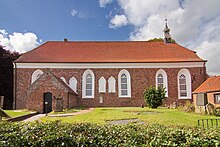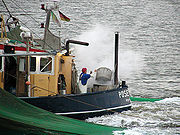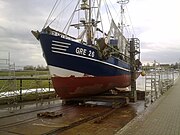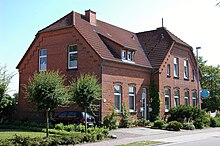Greetsiel
|
Greetsiel
Krummhörn municipality
|
|
|---|---|
| Coordinates: 53 ° 30 ′ 4 ″ N , 7 ° 5 ′ 30 ″ E | |
| Height : | 1 (0–1) m above sea level NHN |
| Area : | 15.17 km² |
| Residents : | 1450 (December 31, 2012) |
| Population density : | 96 inhabitants / km² |
| Incorporation : | July 1, 1972 |
| Postal code : | 26736 |
| Area code : | 04926 |
|
Map of the municipality of Krummhörn
|
|
Greetsiel is a district of the municipality of Krummhörn in the Aurich district in Lower Saxony .
geography
The Sielort is located directly on the Leybucht , a small bay on the East Frisian west coast. Large parts of the bay were gradually diked , so that Greetsiel is the only port on the Leybucht today. Greetsiel also includes the suburb of Hauen and the habitat of Akkens on a terp, both to the west of the village.
The Leybuchthörn was completed in the 1990s . This structure extends as a headland into the Wadden Sea . Within the Leybuchthörn there is a storage basin and the access from the North Sea to Greetsieler Hafen. There is a lock between the port and the open sea . Since the completion of the structure, Greetsieler Hafen has been accessible regardless of the tide .
The distance to the nearest cities Emden and the north is 15 to 20 kilometers to the north or south-west. The main town of Krummhorn, Pewsum, is 7.2 kilometers to the south.
To the west of Greetsiel is the Leyhörn nature reserve , which is part of the Krummhörn EU bird sanctuary . The protected area is 646 hectares and includes the water and mudflats extensive reedbeds , Hochstaudenfluren and grassland areas . The place also borders the Lower Saxony Wadden Sea National Park .
history
Greetsiel can look back on over 650 years of history. Greetsiel is mentioned for the first time in letters from 1388 ( Ocko I. tom Brok ). Hamburg ships were anchored in the port of Greetsiel and had to pay customs duties .
Chiefs of the Cirksena dynasty founded the place from the Appingen domain . The family provided the counts and princes of East Frisia from 1464 to 1744 . While the mother place subsequently lost more and more importance, Greetsiel became the seat of the chief. In 1462 Count Edzard the Great was born on the Cirksenaburg , under whose rule East Frisia stretched from the Weser to Groningen . Ubbo Emmius was born here in 1547 . The place is marked as Grietjezijl on old Dutch maps .
In the course of the Hanoverian office reform in 1859, the Greetsiel office , whose seat was in Pewsum, was dissolved and added to the Emden office, Greetsiel has since belonged to the latter. During the Prussian district reform in 1885 , the Emden district was formed from the Emden district , to which Greetsiel then belonged.
For centuries, the natural depths and drainage channels that crisscross the Krummhörn in a dense network were the most important modes of transport. Not only the villages but also many farms were connected to the city of Emden and the port of Greetsiel via ditches and canals. The boat traffic with Emden was particularly important. Village boatmen took over the supply of goods from the city and delivered agricultural products in the opposite direction: “From the Sielhafenort, smaller ships, so-called Loog ships, transported the cargo to the inland and supplied the marsh villages (loog = village). The loog ships from the Krummhörn enlivened the canals of the city of Emden until the 20th century. "
Peat, which was mostly extracted in the East Frisian Fehnen , played an important role as heating material for the inhabitants of the Krummhörn for centuries . The peat ships brought the material on the East Frisian canal network to the Krummhörn villages, including Greetsiel. On their way back into the Fehnsiedlungen the Torfschiffer often took clay soil from the march and the manure of cattle with which they their home were dug fertilized land.
In April 1919 there were so-called "bacon removals" from Emden workers, which were followed by rioting on the farm workers. Together with the Rheiderland , the district of Emden was the part of East Frisia most affected by this unrest. Workers broke into the surrounding villages in closed trains and stole food from farmers in clashes. The situation only calmed down after the deployment of the Reichswehr troops stationed in the region . As a reaction to this, resident groups were formed in almost all villages in the Emden area . The Greetsiel Rescue Service comprised 70 people. These had 30 weapons. The resident services were only dissolved after a corresponding decree by the Prussian Interior Minister Carl Severing on April 10, 1920.
Explanation of the place name
Old names of the place are 1388 Greit, 1388 Gredsyle, 1787 Greetsyhl and 1787 Greete. The seat of the Cirksena family was built near the end of the 14th century. It is a composition with “gred” for meadow, pasture land, alluvial land, ie “Siel am Neuland”. Sluice as a passage for sewage, dyke sluice with drainage and drainage ditches for the passage or drainage of inland water.
Incorporations
On July 1, 1972, Greetsiel was incorporated into the new municipality of Krummhörn. With the formation of this new congregation, a discussion arose about the administrative seat - Pewsum or Greetsiel. Because of its more central location, Pewsum was preferred and grew very rapidly as a result. Today Pewsum has a population more than twice as high as Greetsiel (only main residences).
Population development
|
|
|
politics
City council and mayor
Since the municipal reform in 1972 , Greetsiel has been represented by the Krümmhörner municipal council.
Mayor
The head of the village is Alfred Jacobsen.
coat of arms
Greetsiel does not have an official coat of arms, as the place is no longer an independent municipality. The coat of arms of the former municipality of Greetsiel shows a three-masted sailing ship in blue, which symbolizes Greetsiel's importance as a former sea trading center and fishing port. On the middle mast there is a golden harpy , the heraldic animal of the Cirksena family , on a black background . The three six-pointed spur wheels on the masts indicate that it was part of the north district; the spur wheels are an element of the northern city arms .
Culture and sights
Buildings
In the town center there are numerous monuments with historical, artistic or urban significance.
The Reformed Church is a rectangular brick - hall church with Gothic lancet windows and was built from 1380 to 1410 as principal church of the chief Haro Edzardsna in two phases. In 1401 she was given by Pope Boniface IX. confirmed, long before its final completion, it should have been consecrated to St. Mary until the Reformation and belonged to the diocese of Münster . The building is crowned by a small roof turret equipped with a clock. This is adorned with a weather vane in the form of a ship from around 1730 . It shows a three-master with three square sails set. The actual bell tower is a little apart. The ringing consists of three bells that were cast by the Bachert bell foundry in 1958 for the Evangelical Kreuzkirche, which was demolished in 2012, in the Mannheim district of Neckarstadt-Ost / Wohlhotels . The simple interior of the church, formerly closed off by a flat ceiling, has been spanned by a slightly arched wooden ceiling since 1852. The first organ was taken over by the Aland monastery in 1555 . This was replaced by a new organ from 1694–1895 by the organ builder Valentin Ulrich Grotian . In 1738 a new organ was built by Johann Friedrich Constabel . The organ front with valuable carvings is still preserved from that time. In 1914 only the case of the organ was kept and replaced by a new organ by Friedrich Klassmeier . The organ that exists today was built in 1963 by the Karl Schuke Berlin organ building workshop. The pulpit, however, was created in 1669.
The stone house , the former headquarters of the Cirksena family, is located at the end of Hohen Strasse. The brick building was erected around 1600 on the foundations of a previous building dating from around 1390. Inside, the original hall was restored during the renovation work. The row of houses flanking the harbor basin on Sielstrasse is one of the most famous photo motifs of the place . The houses No. 11 and No. 15 with their bell-shaped gables based on Dutch models are particularly striking here. While the former is dated 1741, No. 15 was built in 1792. Poppinga's old bakery (No. 21) from the 19th century is also located on Sielstrasse . With its unchanged interior, it is now used as a museum, café and gallery. Not far from the church is the so-called Hohe Haus (Hohe Straße 1), a two-storey eaves brick building that once served as the seat of the rent master . It is dated to "1696" due to the wall anchors on the gable, but its core is likely to go back to the 16th century. Today the building, the street facade of which is plastered, houses a hotel. The Amtmannshaus on Neuer Deich is likely to date from the same time, although it was thoroughly renovated in the 19th century. During the most recent renovation, the external appearance of the house and the associated Gulf barn was significantly changed with modern dormer windows . In Mühlenstraße you come across Halem's house , which was built in 1794 and is one of the most important classicist residential buildings in East Frisia. The two-storey brick building with a hipped roof is structured by colossal pilasters . The portal has a richly carved skylight in late Rococo forms .
The twin mills are also among the most famous sights . The Dutch windmills date from 1856 (green mill) and 1706 (red mill, renewed in 1921 from parts of the Aurich wall mill from 1750).
Further sights are the pumping station , the old sewer (1798), the new sewer (1887). The Greetsieler museum house specializes in ships in bottles and shows around 800 examples. According to the museum, it is one of the largest ship-in-bottle collections in Germany and Europe. Additional maritime exhibits can also be seen. Nearby, but already in the Pilsum district, is the Pilsum lighthouse .
Regular events
The Greetsieler Woche has been taking place in Greetsiel every year for more than 40 years , an art exhibition from the fields of painting, ceramics, goldsmiths and sculpture. Every two years, the Imke Folkerts Prize for Fine Arts , endowed with 10,000 euros, is awarded at the exhibition - in years of uneven years. Works from the fields of painting, drawing, graphics, photography and sculpture are eligible. Exhibitions can also be seen regularly in the Greetsiel twin mills. Every year in midsummer the cutter parade takes place, in which most of the Greetsiel cutters take part. The crews take guests on a four-hour journey. A supporting program with music and shrimp pulp competitions also takes place in the harbor.
Economy and Infrastructure
Companies
Greetsiel is characterized by tourism and fishing, in the immediate vicinity of the place agriculture is also important.
There are currently 27 shrimp cutters in the fishing port . With 27 shrimp cutters, the place is one of the larger German cutter ports, and a little more than ten percent of the almost 250 German shrimp cutters are based in Greetsiel. The shrimp trading company de Beer is based in Greetsiel. It employs around 80 full-time and 15 part-time employees. In addition to the wholesale of the North Sea shrimp, de Beer is also active in the retail and fish restaurant sector, including two shops in Greetsiel. The slipway is increasingly being used to overhaul the shrimp cutters from the neighboring north dike.
The municipality of Krummhörn records more than 400,000 overnight stays as well as around one million day visitors, the majority of which are at Greetsiel. There are several hotels and a large number of guest houses, holiday apartments and houses available in the village. Holidays on the farm are also possible in the Greetsiel district. There is also a motorhome parking space with 55 spaces. On the other hand, there is no campsite in Greetsiel, the closest ones are in the Krummhörner villages of Campen and Upleward. In the winter half-year the hotel ship Dutch Princess is also moored in Greetsieler Hafen. Yacht owners can moor in the marina.
The oasis with swimming pool, sauna and other health facilities is part of the tourist infrastructure in Greetsiel .
In Greetsiel, one of the two industrial parks is in the municipality of Krummhörn, the other (larger) is in the main town of Pewsum . The Greetsiel industrial park is on the state road in the direction of Eilsum .
media
Greetsiel has already been used several times as a backdrop for film and television recordings:
- The episode Sun and Storm of the ARD crime series Tatort (NDR - Charlotte Lindholm) was shot in 2003 in Greetsiel, which embodies the fictional coastal town of "Nordersiel". In addition, the neighboring Pilsum lighthouse also plays an important role.
- The episode of the homeland stories "The Legacy of Greetsiel" was filmed in 1998 with the actors Dieter Pfaff and Ferdinand Dux in Greetsiel.
- The first two episodes of The Seventh Temple and The Skeleton in the Dunes of the Ottfried Fischer series Pfarrer Braun were shot against the backdrop of Greetsiel, Pilsum and Norderney .
- In the opening credits of the film Otto - Der Ausserfriesische , aerial photos of Greetsiel can be seen.
traffic
Greetsiel is connected to Emden and thus the A 31 and the city of the north via state roads. The L 25 connects Greetsiel with Eilsum , from where the seaport city can be reached via state roads (L 4 to Pewsum, further to Emden on the L 3). The L 27 leads from Greetsiel to the north of the city. In addition, the district road 139 leads from Greetsiel via Pilsum to Groothusen , where the L 2 (Pewsum-Rysum-Emden) is reached. The fishing village is therefore connected to the road network to the north, west and south. The place itself is relieved by a bypass road in the course of the L 27 / K 139, on the western edge of Greetsiel is the intersection with the L 25 and the main access road into the place. The center of Greetsiel is traffic-calmed, the entrance is only permitted for residents. Due to their dimensions, individual lanes are not passable for cars at all. To get from the eastern part of Greetsiel to the new development areas in the west, the bypass road must be used. There are extensive networks of cycle paths around Greetsiel, and the place is also on the North Sea Coast cycle path .
Greetsiel can also be reached with smaller boats from the direction of Emden. The old Greetsieler Sieltief and the new Greetsieler Sieltief connect the place with the East Frisian inland waterway network. The old Greetsieler Sieltief leads from Greetsiel via Eilsum and Grimersum past Werdenum to Loppersum, where it flows into the Knockster Tief . The New Greetsieler Sieltief leads from Greetsiel via Visquard through the Meeden of the Krummhörn and flows into the Knockster Tief at Hinte . Further lows branch off these two channels. In Greetsiel, the old and the new Sieltief enclose part of the town center, so that it almost forms an island. The pumping station in the town center, the drainage area safe, but does not have a lock , so in Greetsiel no smuggling boats from within by butene , ie from the inland canals to the port and thus are possible in the North Sea.
The Greetsieler Hafen consists of the fishing port on the west side and the marina on the east side of the port basin. Since the Leyhörn headland was completed, a tide-independent fairway has led from Greetsieler Hafen to the Außenems. The Leysiel lock is located at the tip of the headland . There are no regular ferry connections from Greetsiel, only excursion traffic. In earlier centuries, however, Greetsiel was the main ferry port to Borkum , before Emden took over this function due to the increasing ship sizes and the more favorable fairway conditions in the Ems .
In the past, the Emden – Pewsum – Greetsiel circuit connected the towns of Pewsum and Greetsiel with Emden. The meter-gauge railway began operating between Emden and Pewsum in 1899, and in 1906 the line was extended to Greetsiel. The Kleinbahnstraße in Greetsiel reminds of this time, on which there are still several train station buildings, which are used for other purposes today. The operation of the small train was discontinued in 1963, since then buses have taken over passenger transport . Greetsiel is now connected by bus with the former district town of Norden and - via Pewsum and Hinte - with Emden.
Personalities
Sons and daughters of the place
- Edzard I (called "the Great") (1461–1528), Count of East Frisia
- Ubbo Emmius (1547–1625), Evangelical Reformed theologian, historian, educator and founding rector of the Dutch University of Groningen
- Edzard II (1560–1599), Count of East Friesland
Web links
Individual evidence
- ^ Ordinance on the reorganization of administrative offices, 1859. pp. 675 ff., Accessed on May 21, 2013.
- ^ Harm Wiemann / Johannes Engelmann: Old streets and ways in East Frisia . Self-published, Pewsum 1974, p. 169 (Ostfriesland in the protection of the dike; 8).
- ^ Gunther Hummerich: The peat shipping of the Fehntjer in Emden and the Krummhörn in the 19th and 20th centuries. In: Emder Yearbook for Historical Regional Studies in Ostfriesland , Volume 88/89 (2008/2009), pp. 142–173, here p. 163.
- ↑ Hans Bernhard Eden: The Resident Services of East Frisia from 1919 to 1921 . In: Emder yearbook for historical regional studies of East Frisia . Vol. 65 (1985), pp. 81-134, here pp. 94, 98, 105, 114.
- ^ Förstemann, Ernst: Old German name book . tape 2 . Nordhausen 1872, p. 661 .
- ^ Jürgen Udolph (research): The "place name researcher". In: website NDR 1 Lower Saxony . Archived from the original on December 2, 2016 ; accessed on October 9, 2018 .
- ^ Federal Statistical Office (ed.): Historical municipality directory for the Federal Republic of Germany. Name, border and key number changes in municipalities, counties and administrative districts from May 27, 1970 to December 31, 1982 . W. Kohlhammer, Stuttgart / Mainz 1983, ISBN 3-17-003263-1 , p. 263 f .
- ↑ Heike Rohlfs-Jacobs: For him, the mayor is “the best job”. In: Website Ostfriesen Zeitung. May 10, 2017. Retrieved October 9, 2018 .
- ↑ GREETSIEL CORE RENOVATION. Historic town center. (PDF; 8.4 MB) In: Website of the municipality of Krummhörn. June 2015, accessed October 23, 2017 .
- ↑ das-radland.de: Buddelschiffmuseum , accessed on 23 January 2016th
- ↑ greetsiel.de: Kutterkorso ( memento from March 23, 2012 in the Internet Archive ), accessed on June 2, 2011.
- ^ Sönke Fischer (WWF): Not just crabs on the net. February 2009, accessed on June 2, 2011. P. 7 (PDF; 2.4 MB).
- ↑ dutch-princess.com: Overnight , accessed on 2 June 2011th
- ↑ yachtclub-greetsiel.de , accessed on 2 June 2011th
















